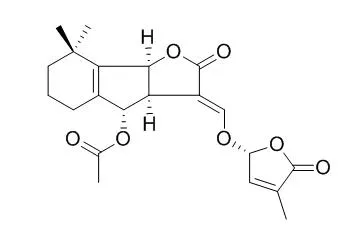| In vitro: |
| New Phytologist, 2008, 179(2):484. | | Strigolactones, host recognition signals for root parasitic plants and arbuscular mycorrhizal fungi, from Fabaceae plants.[Pubmed: 19086293] | Both root parasitic plants and arbuscular mycorrhizal (AM) fungi take advantage of strigolactones, released from plant roots as signal molecules in the initial communication with host plants, in order to commence parasitism and mutualism, respectively.
METHODS AND RESULTS:
In this study, strigolactones in root exudates from 12 Fabaceae plants, including hydroponically grown white lupin (Lupinus albus), a nonhost of AM fungi, were characterized by comparing retention times of germination stimulants on reverse-phase high-performance liquid chromatography (HPLC) with those of standards and by using tandem mass spectrometry (LC/MS/MS). All the plant species examined were found to exude known strigolactones, such as orobanchol, Orobanchyl acetate, and 5-deoxystrigol, suggesting that these strigolactones are widely distributed in the Fabaceae. It should be noted that even the nonmycotrophic L. albus exuded orobanchol, Orobanchyl acetate, 5-deoxystrigol, and novel germination stimulants. By contrast to the mycotrophic Fabaceae plant Trifolium pratense, in which phosphorus deficiency promoted strigolactone exudation, neither phosphorus nor nitrogen deficiency increased exudation of these strigolactones in L. albus.
CONCLUSIONS:
Therefore, the regulation of strigolactone production and/or exudation seems to be closely related to the nutrient acquisition strategy of the plants. |
|






 Cell. 2018 Jan 11;172(1-2):249-261.e12. doi: 10.1016/j.cell.2017.12.019.IF=36.216(2019)
Cell. 2018 Jan 11;172(1-2):249-261.e12. doi: 10.1016/j.cell.2017.12.019.IF=36.216(2019) Cell Metab. 2020 Mar 3;31(3):534-548.e5. doi: 10.1016/j.cmet.2020.01.002.IF=22.415(2019)
Cell Metab. 2020 Mar 3;31(3):534-548.e5. doi: 10.1016/j.cmet.2020.01.002.IF=22.415(2019) Mol Cell. 2017 Nov 16;68(4):673-685.e6. doi: 10.1016/j.molcel.2017.10.022.IF=14.548(2019)
Mol Cell. 2017 Nov 16;68(4):673-685.e6. doi: 10.1016/j.molcel.2017.10.022.IF=14.548(2019)